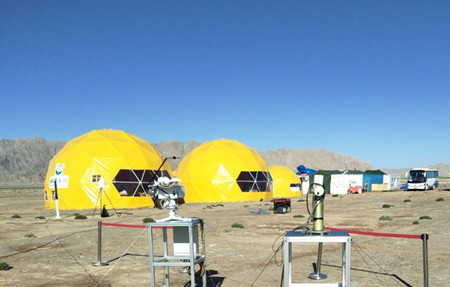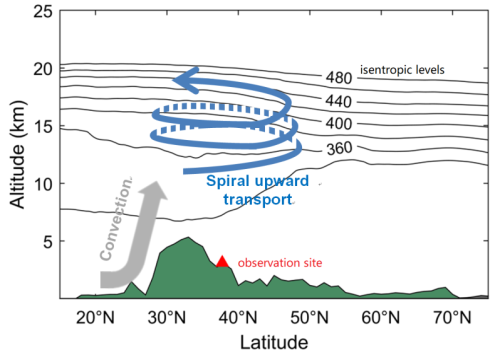ERL: Pollution in the Asian Tropopause Layer Comes from Human Activities and Natrual Sources
Date:2020-06-12
The Asian Tropopause Aerosol Layer (ATAL) is a thin layer of aerosol with a thickness of about 3–4 km, which appears regularly at the height of the tropopause layer during the Asian summer monsoon (ASM) period over the Tibetan Plateau. How is it formed? Where are aerosols from? There are questions in debate since the discovery of ATAL in 2011.
Drs. ZHANG Jinqiang and WU Xue from the Key Laboratory of Middle Atmosphere and Global Environment Observation of the Institute of Atmospheric Physics at Chinese Academy of Sciences (CAS), in collaboration with scientists from the CAS Aerospace Information Research Institute, conducted in situ observations using a balloon-borne portable optical particle counter (POPS), aiming to further understand the composition and sources of the ATAL. The observation campaigns were conducted in the summer of 2018 and 2019 at Golmud and Qaidam in Qinghai Province of China.

The camp of 2019 summer campaign at Qaidam, Qianghai, China. (Image by ZHANG Jinqiang)
"If we would like to further understand the possible source regions of the observed aerosols, a Lagrangian particle dispersion model is the right tool to do the job," said WU.
They combined the observations with the simulation results from a Lagrangian model called MPTRAC and found that part of the aerosol in the ATAL is transported vertically from the Earth surface at the southwest of the Himalayas to the ATAL by the convection formed during the ASM season; while the majority of the aerosols could be transported from the upper troposphere to the tropopause layer via a spiral upward transport inside of the ASM anticyclone. So the composition of the aerosols in Southwest Asia in the boundary layer, as well as the aerosols in the upper troposphere may eventually influence the ATAL.

The schematic figure of the two transport pathways for aerosols. (Image by WU Xue)
"The aerosols in the boundary layer are mostly pollution out of human activities, and the aerosols in the upper troposphere may also contain natural aerosols, like mineral dust and volcanic sulfate aerosols," concludes WU.
In situ observations for multiple years are essential to studying the ATAL, and ZHANG is now preparing campaign in the 2020 summer.
Their studies are recently published in Environmental Research Letters. ZHANG is the first author and WU is the correspondence author.
Their work is co-sponsored by the Strategic Priority Research Program of the Chinese Academy of Sciences (grant no. DA17010101) and the National Natural Science Foundation of China (the Joint Sino-German Research Project grant no. 41861134034).
Reference: Jinqiang Zhang, Xue Wu*, Jianchun Bian, Xiangao Xia, Zhixuan Bai, Yi Liu, Zhaonan Cai, Juan Huo, and Daren Lyu, 2020: Aerosol variations in the upper troposphere and lower stratosphere over the Tibetan Plateau, Environ. Res. Lett., https://iopscience.iop.org/article/10.1088/1748-9326/ab9b43
Media Contact: Ms. LIN Zheng, jennylin@mail.iap.ac.cn
